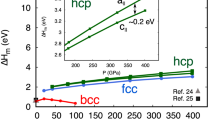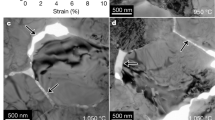Abstract
Deformation of solid materials affects not only their microstructures, but also their microchemistries1,2,3,4,5. Although chemical unmixing of initially homogeneous multicomponent solids is known to occur during deformation by diffusion creep4,5, there has been no report on their chemical zoning due to deformation by dislocation creep, in either natural samples or laboratory experiments. Here we report striped iron zoning of olivine ((Mg,Fe)2SiO4) in deformed peridotites, where the iron concentration increases at subgrain boundaries composed of edge dislocations. We infer that this zoning is probably formed by alignment of edge dislocations dragging a so-called Cottrell ‘atmosphere’ of solute atoms3,6,7 (iron in this case) into subgrain boundaries during deformation of the olivine by dislocation creep. We have found that the iron zoning does not develop in laboratory experiments of high strain rates where dislocations move too fast to drag the Cottrell atmosphere. This phenomenon might have important implications for the generation of deep-focus earthquakes, as transformation of olivine to high-pressure phases preferentially occurs in high-iron regions, and therefore along subgrain boundaries which would be preferentially aligned in plastically deformed mantle peridotites.
This is a preview of subscription content, access via your institution
Access options
Subscribe to this journal
Receive 51 print issues and online access
$199.00 per year
only $3.90 per issue
Buy this article
- Purchase on Springer Link
- Instant access to full article PDF
Prices may be subject to local taxes which are calculated during checkout



Similar content being viewed by others
References
Li, J. C. M., Nolfi, F. V. Jr & Johnson, C. A. Diffusional equilibrium of substitutional atoms in a stressed solid. Acta Metall. 19, 749–752 (1971).
Green, H. W. II On the thermodynamics of non-hydrostatically stressed solids. Phil. Mag. 41, 637–647 (1980).
Kitamura, M., Matsuda, H. & Morimoto, N. Direct observation of the Cottrell atmosphere in olivine. Proc. Jpn Acad. 62, 149–152 (1986).
Dimos, D., Wolfenstine, J. & Kohlstedt, D. L. Kinetic demixing and decomposition of multicomponent oxides due to a nonhydrostatic stress. Acta Metall. 36, 1543–1552 (1988).
Ozawa, K. Stress-induced Al–Cr zoning of spinel in deformed peridotites. Nature 338, 141–144 (1989).
Cottrell, A. H. in Report of the Strength of Solids 30–36 (The Physical Society, London, 1948).
Blavette, D., Cadel, E., Fraczkiewicz, A. & Menand, A. Three-dimensional atomic-scale imaging of impurity segregation to line defects. Science 286, 2317–2319 (1999).
Ben Ismail, W. & Mainprice, D. An olivine fabric database: An overview of upper mantle fabrics and seismic anisotropy. Tectonophysics 296, 145–157 (1998).
Kohlstedt, D. L., Goetze, C., Durham, W. B. & Vandersande, J. B. New technique for decorating dislocations in olivine. Science 19, 1045–1091 (1976).
Karato, S. Scanning electron microscope observation of dislocations in olivine. Phys. Chem. Minerals 14, 245–248 (1986).
Ozawa, K. Partitioning of elements between constituents minerals in peridotites from the Miyamori ultramafic complex, Kitakami Mountains, Northeast Japan: Estimation of P-T condition and igneous composition of minerals. J. Fac. Sci. Univ. Tokyo II 21, 115–137 (1986).
Kawasaki, T & Ito, E. An experimental determination of the exchange of Fe2+ and Mg2+ between olivine and Ca-rich clinopyroxene. Am. Mineral. 79, 461–477 (1994).
McGuire, A. V., Dyar, M. D. & Nielson, J. E. Metasomatic oxidation of upper mantle peridotite. Contrib. Mineral. Petrol. 109, 252–264 (1991).
Banfield, J. F., Dyar, M. D. & McGuire, A. V. The defect microstructure of oxidized mantle olivine from Dish Hill, California. Am. Mineral. 77, 977–986 (1992).
Carter, N. L. & Ave Lallemant, H. G. High temperature flow of dunite and peridotite. Geol. Soc. Am. Bull. 81, 2181–2202 (1970).
Furusho, M. & Kanagawa, K. Transformation-induced strain localization in a lherzolite mylonite from the Hidaka metamorphic belt of central Hokkaido, Japan. Tectonophysics 313, 411–432 (1999).
Ito, E. & Sato, H. in High-Pressure Research: Application to Earth and Planetary Sciences (eds Syono, Y. & Manghnani, H.) 257–262 (Terrapub/American Geophysical Union, Tokyo/Washington DC, 1992).
Iidaka, T. & Furukawa, Y. Double seismic zone for deep earthquakes in the Izu-Bonin subduction zone. Science 263, 1116–1118 (1994).
Kirby, S. H., Stein, S., Okal, E. A. & Rubie, D. C. Metastable mantle phase transformations and deep earthquakes in subducting oceanic lithosphere. Rev. Geophys. 34, 261–306 (1996).
Kirby, S. H. Localized polymorphic phase transformations in high-pressure faults and applications to the physical mechanism of deep earthquakes. J. Geophys. Res. 92, 13789–13800 (1987).
Green, H. W. II & Burnley, P. C. A new self-organizing mechanism for deep-focus earthquakes. Nature 341, 733–737 (1989).
Kirby, S., Durham, W. B. & Stern, L. A. Mantle phase changes and deep-earthquake faulting in subducting lithosphere. Science 252, 216–225 (1991).
Burnley, P. C., Green, H. W. II & Prior, D. J. Faulting associated with the olivine to spinel transformation in Mg2GeO4 and its implications for deep focus earthquakes. J. Geophys. Res. 96, 425–443 (1991).
Tingle, T. N., Green, H. W. II, Scholtz, C. H. & Koczynnski, T. A. The rheology of faults triggered by the olivine–spinel transformation in Mg2GeO4 and its implications for the mechanism of deep focus earthquakes. J. Struct. Geol. 15, 1249–1256 (1993).
Katsura, T. & Ito, E. The system Mg2SiO4 – Fe2SiO4 at high pressure and temperatures: precise determination of stabilities of olivine, modified spinel, and spinel. J. Geophys. Res. 94, 15663–15670 (1989).
Akaogi, M., Ito, E. & Navrotsky, A. Olivine-modified spinel-spinel transitions in the system Mg2SiO4 – Fe2SiO4 : calorimetric measurements, thermochemical calculation, and geophysical. J. Geophys. Res. 94, 15671–15685 (1989).
Poirier, J.-P. in Anelasticity in the Earth (eds Stacey, F. D., Paterson, M. S. & Nicholas, A.) 113–117 (American Geophysical Union and Geological Society of America, Washington DC/Boulder, 1981).
Kerschhofer, L., Rubie, D. C., Sharp, T. G., McConnell, J. D. C. & Dupas-Bruzek, C. Kinetics of intracrystalline olivine–ringwoodite transformation. Phys. Earth Planet. Inter. 121, 59–76 (2000).
Poirier, J.-P. in Creep of Crystals 62–63 (Cambridge Univ. Press, Cambridge, 1985).
Yoshinaga, H. in Rheology of Solids and of the Earth (eds Karato, S. & Toriumi, M.) 29–41 (Oxford Science Publications, New York, 1989).
Acknowledgements
We thank K. Ozawa for critical reading of the manuscript, H. Ishisako for making thin sections, Y. Takahashi for his contribution to the XANES study at the KEK photon factory in Tsukuba, Japan, and N. Abe for supplying the specimens from the southern Alps. This study was supported by JSPS (J.A.).
Author information
Authors and Affiliations
Corresponding author
Ethics declarations
Competing interests
The authors declare no competing financial interests.
Rights and permissions
About this article
Cite this article
Ando, J., Shibata, Y., Okajima, Y. et al. Striped iron zoning of olivine induced by dislocation creep in deformed peridotites. Nature 414, 893–895 (2001). https://doi.org/10.1038/414893a
Received:
Accepted:
Issue Date:
DOI: https://doi.org/10.1038/414893a
This article is cited by
-
Syntheses and applications of iron-based functional materials for bioenergy production: a review
Biomass Conversion and Biorefinery (2023)
-
Disorientation control on trace element segregation in fluid-affected low-angle boundaries in olivine
Contributions to Mineralogy and Petrology (2021)
-
A 2D and 3D nanostructural study of naturally deformed pyrite: assessing the links between trace element mobility and defect structures
Contributions to Mineralogy and Petrology (2019)
-
Lattice distortion in a zircon population and its effects on trace element mobility and U–Th–Pb isotope systematics: examples from the Lewisian Gneiss Complex, northwest Scotland
Contributions to Mineralogy and Petrology (2013)
-
The legacy of crystal-plastic deformation in olivine: high-diffusivity pathways during serpentinization
Contributions to Mineralogy and Petrology (2012)
Comments
By submitting a comment you agree to abide by our Terms and Community Guidelines. If you find something abusive or that does not comply with our terms or guidelines please flag it as inappropriate.



